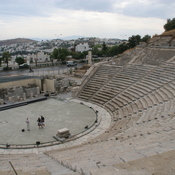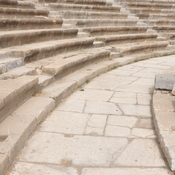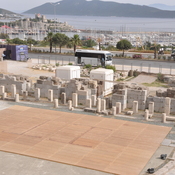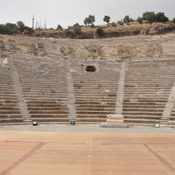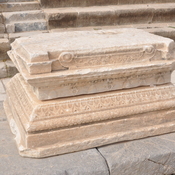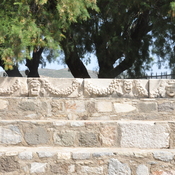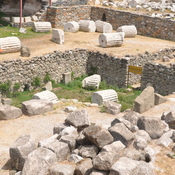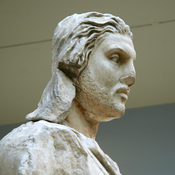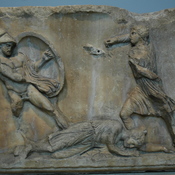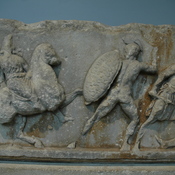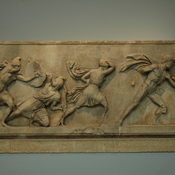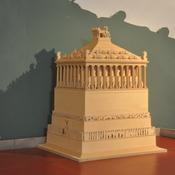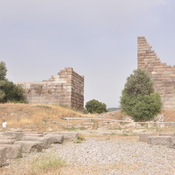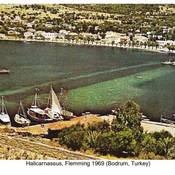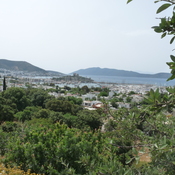Es gibt noch keine deutschsprachige Anmerkungen. Präsentiert wirden Anmerkungen auf English.
Accordng to Strabo Leleges settled down in Halicarnassus after the War of Troy established many cities and among them Pedasa1. However, the city Pedasus, now abandoned by them, is no longer in existence; but in the inland territory of the Halicarnassians there used to be a city Pedasa, so named by them; and the present territory is called Pedasis. It is said that as many as eight cities were settled in this territory by the Leleges, who in earlier times were so numerous that they not only took possession of that part of Caria which extends to Myndus and Bargylia, but also cut off for themselves a large portion of Pisidia. But later, when they went out on expeditions with the Carians, they became distributed throughout the whole of Greece, and the tribe disappeared. Of the eight cities, Mausolus united six into one city, Halicarnassus, as Callisthenes tells us, but kept Syangela and Myndus as they were. These are the Pedasians of whom Herodotus says that when any misfortune was about to come upon them and their neighbors, the priestess of Athena would grow a beard; and that this happened to them three times. And there is also a small town called Pedasum in the present territory of Stratoniceia. And throughout the whole of Caria and in Miletus are to be seen tombs, fortifications, and traces of settlements of the Leleges2.
- George E. Bean, Turkey Beyond the Maeander. An Archaeological Guide, London Ernest Jersey 1971, p.119-122
- http://tayproject.org/TAYages.fm$Retrieve?CagNo=5427&html=ages_maps_t.html&layout=web
- Strabo. ed. H. L. Jones, The Geography of Strabo. Cambridge, Mass.: Harvard University Press; London: William Heinemann, Ltd. 1924, XIII, 3. 1. 59, and VII, 7.2
Referenzen
- ↑George E. Bean, Turkey Beyond the Maeander. An Archaeological Guide, London Ernest Jersey 1971, p.101
- ↑Strabo XIII.1.59
Accordng to Strabo Leleges settled down in Halicarnassus after the War of Troy established many cities and among them Pedasa1. However, the city Pedasus, now abandoned by them, is no longer in existence; but in the inland territory of the Halicarnassians there used to be a city Pedasa, so named by them; and the present territory is called Pedasis. It is said that as many as eight cities were settled in this territory by the Leleges, who in earlier times were so numerous that they not only took possession of that part of Caria which extends to Myndus and Bargylia, but also cut off for themselves a large portion of Pisidia. But later, when they went out on expeditions with the Carians, they became distributed throughout the whole of Greece, and the tribe disappeared. Of the eight cities, Mausolus united six into one city, Halicarnassus, as Callisthenes tells us, but kept Syangela and Myndus as they were. These are the Pedasians of whom Herodotus says that when any misfortune was about to come upon them and their neighbors, the priestess of Athena would grow a beard; and that this happened to them three times. And there is also a small town called Pedasum in the present territory of Stratoniceia. And throughout the whole of Caria and in Miletus are to be seen tombs, fortifications, and traces of settlements of the Leleges2.
- George E. Bean, Turkey Beyond the Maeander. An Archaeological Guide, London Ernest Jersey 1971, p.119-122
- http://tayproject.org/TAYages.fm$Retrieve?CagNo=5427&html=ages_maps_t.html&layout=web
- Strabo. ed. H. L. Jones, The Geography of Strabo. Cambridge, Mass.: Harvard University Press; London: William Heinemann, Ltd. 1924, XIII, 3. 1. 59, and VII, 7.2
Referenzen
- ↑George E. Bean, Turkey Beyond the Maeander. An Archaeological Guide, London Ernest Jersey 1971, p.101
- ↑Strabo XIII.1.59

